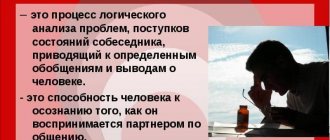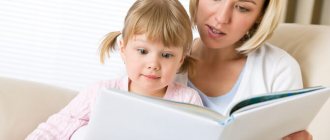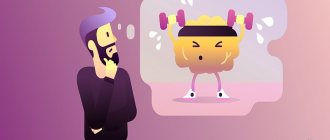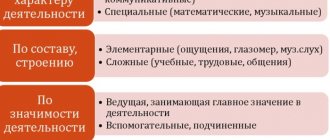Since development and learning are internal processes, it will not be possible to control them by external means, for example, coercion. To direct them in a certain direction and help the child understand the material, the teacher must first imagine these internal processes and, if possible, make adjustments to them. Reflection on pedagogical activity is an introspective beginning of knowledge of oneself and others.
This ability is extremely necessary for a school teacher. In fact, this is one of those personality qualities that are necessary for a student who has chosen a pedagogical university.
general characteristics
With the development of philosophy, man became more and more aware of his inner world. A theory of knowledge appeared, and within its framework - the concept of reflection. What it is? Reflection makes it possible to understand your mental activity and its direction.
To understand the meaning of the word more clearly, you need to look at the roots of the concept. The word “reflection” is translated as “return.” The authors define reflection in different ways, but we will focus on one, clearer and more specific definition. Pedagogical reflection is a certain way of thinking aimed at understanding the components of the pedagogical process.
Using this method of self-knowledge, the teacher comprehends not only children's problems, but also his thoughts and his means of thinking. Choosing a means of understanding life is the highest level of reflection.
Forms and types of reflection
We described reflection as a complex process directed both within oneself and into the external world, leading to benefit for the individual, or, on the contrary, to its destruction. Let's consider what forms and types of introspection exist in psychology.
From the point of view of the impact on the future state of a person:
- Correct constructive self-analysis, which allows you to understand yourself, draw logical conclusions and not step on familiar mistakes again.
- Harmful destructive self-analysis, leading to neurotic disorders and deep fixation on problems, often imaginary. In such situations, feelings of guilt, helplessness and hopelessness are cultivated. A person needs the help of a specialist.
Taking into account time periods, reflection occurs:
- Event-based or situational . The individual analyzes a problem that takes place in the present time, “here and now.”
- Retrospection , looking to the past. A person evaluates past events and his actions, draws conclusions about their correctness and timeliness.
- Perspective , facing future events. The individual plans further actions and events based on self-analysis.
Based on the object of study, the process can be divided into the following forms:
- Self-reflection , turning to one’s own inner world, personal experiences and emotions.
- Communicative . In this form, reflection is devoted to other people, interaction with friends, relatives, and colleagues. A person tries to analyze relationships and interactions.
- Sanogenic is a type of self-analysis in which a substantive study of strong emotions is carried out, a search for means to minimize or eliminate unnecessary suffering and experiences.
- Intelligent . The individual’s attention is focused on the application of knowledge, skills, and the possibilities of their use in the material world.
A combination of forms of reflection under given conditions gives the best results; it is always necessary to combine methods of analysis for a specific situation.
Reflection in philosophy, psychology and pedagogy
The word “reflection” was introduced into philosophy in the 17th century by John Locke. He understood reflection as a mental process that helps to find and accumulate new ideas. Rene Descartes described it as the ability of an individual to concentrate on the content of his thoughts. In psychology, reflection is considered as getting used to the old self and analyzing internal values taking into account new experience.
Pedagogy introduced the concept of reflection to teach a young teacher to direct his inner gaze to the “past” self, to all his mistakes in interacting with children.
What is reflection and reflexivity
“Reflecto” translated from Latin means “return back.” The same term in French sounds like “reflexio” and means “thinking, reflection.”
Initially, the concept of reflection appeared in philosophy as a tool for observing the external world and a way of understanding human existence.
Through the analysis of phenomena occurring in nature and society, a person gets to know himself, seeks ways for survival and self-improvement. Today, the process of reflection is studied and used in other fields, in sociology and psychology. Reflection is a person’s look inside himself, analysis of his thoughts and actions and rethinking them.
But this process is not thoughtless, but based on acquired knowledge and experience, examined through one’s own mistakes. In addition, in sociology it is the ability to evaluate other people and make comparisons between them and oneself.
Reflexivity is the ability to analyze oneself, identify the motives of one’s own actions, including:
- past actions and events;
- successful or unsuccessful performance results;
- emotional state;
- personality traits and character that change over time.
The degree of reflection is different for each person and depends on the level of knowledge, intelligence, and upbringing. Some people constantly think about their actions and their motives, while others don’t think about them at all. An important role in this is played by a person’s desire to realize his misconceptions and mistakes, the ability to self-criticize and the need to compare himself with the people around him.
Reflection on pedagogical activity
Unlike epistemological philosophical, teacher reflection is aimed at 3 most important aspects:
- Analysis of your own work.
- Assessment of student performance.
- Assessing student involvement in the cognitive process.
Teacher self-analysis includes the following areas:
- emotional-sensual;
- the sphere of value orientations;
- the scope of determining the level of student needs;
- Gnostic - study of methods of cognition;
- activity sphere of awareness.
The difficulty of teaching is that the teacher’s thinking must constantly be in two dimensions. The teacher, first of all, is the organizer of the educational process, but at the same time he must look at himself and from the children’s side. He needs to understand how his material is perceived.
Reflection on teaching experience develops a young specialist. It is on the basis of rethinking his practice that a teacher can plan his new interesting projects and motivate himself to fully devote himself to the learning process.
Only through reflective mental activity is the teacher able to perceive the student’s personality and build a constructive dialogue with him.
Types of reflective learning
There are many different forms of reflective learning. However, they all have the same basic goal: to achieve the best learning outcomes for both teacher and students. Each reflection model aims to recognize learning to make connections between "doing" and "thinking".
We invite you to consider the main ones.
Flask learning cycle
David Kolb, an educational researcher, developed a four-stage reflective model. In his learning model, he views reflective practice as a tool for drawing conclusions and ideas from experience. The goal is to turn learning into a new experience, completing the cycle completely.
The Flask cycle consists of four stages:
- Study of specific experience. Experiences should be active, used to test new ideas and teaching methods.
- Observing a specific experience and then reflecting on it. Here the student should take into account strengths and areas of development. He also needs to understand what helped the learning process and what hindered it.
- Formation of abstract concepts. The practitioner must figure out what happened. He should change his ideas or develop new approaches based on what he has learned from his own observations and broader research.
- Application of acquired knowledge in practice. The learner's abstract concepts become concrete as he uses them to test ideas in future situations, resulting in new experiences. Ideas from observations and conceptualizations become active experiments as they are implemented in future learning.
Kolb's model focuses on the importance of using both one's own everyday experiences and educational research to help students become better students. To do this, it is not enough to simply think about the problem. This reflection should lead to changes that are rooted in educational research [Cambridge Assessment, 2021].
Gibbs reflexive cycle
The theoretical approach to reflecting the cyclical model was further developed thanks to the model of Professor Graham Gibbs. This model is based on a six-step approach from description of experience to conclusions and considerations for future events.
Although most of the basic principles are similar to Kolb's, Gibbs' model includes several steps that encourage the learner to reflect on his thoughts and feelings.
The Gibbs model is broken down into clearly defined sections:
- Description . At this stage, the practitioner should clearly describe his experience. It should be a factual description of what happened, without analysis, thoughts or feelings.
- Feelings . Here the student explains his feelings and gives examples that directly relate to the learning experience. It is important that he is honest in his manifestations, even if they are negative. Only after all emotions have been identified can the practitioner implement strategies to overcome these obstacles.
- Grade . This stage provides an opportunity for the student to discuss what went well and reflect on the practice. It is also important to consider areas needed for development and things that did not work out as originally planned. This assessment must consider both practitioner learning and student learning.
- Analysis . In this section, the practitioner considers what may have helped or hindered learning. It is at this stage that he turns to any relevant literature or research to help him make sense of the experience.
- Conclusion . At this stage, the student integrates all the ideas together. Now he must form an idea of what he needs to improve or change in his usual strategy.
- Action plan . In the final stage, the practitioner summarizes all the previous elements of this cycle and creates a step-by-step plan for a new learning experience. He determines which habitual strategies and behavior patterns he should maintain and which ones he should change. The action plan may also outline the next steps needed to overcome any obstacles, such as enrolling in a course or shadowing another colleague.
In Gibbs' model, the first three sections are about what happened. The last three sections are about making sense of the experience and how the learner can improve the situation [Cambridge Assessment, 2021].
Reflection in action and reflection on action
Another approach to reflection is reflection in action and reflection on action.
Reflection in action is reflection at the stage of action, i.e. reflecting on a situation while it can still benefit learning. This is done during the lesson, rather than thinking about how things could have been done differently in the future. This method is very effective because it allows you to react and change an event as it happens [Cambridge Assessment, 2021].
Reflection in action allows you to cope with unexpected incidents that may occur in the learning environment. This allows you to be responsible and resourceful, drawing on your own knowledge and allowing you to apply it to new experiences. It also allows for personalized learning because, rather than using preconceived ideas about what should be done in a particular situation, the individual decides what is best for that unique experience and learner at that time.
On the other hand, reflection on action involves thinking about how the practice can be developed after the lesson has been taught. Reflection is needed to discover how our knowledge in action may have contributed to an unexpected outcome” [Cambridge Assessment, 2021].
Reflection on action means that analysis is devoted to past events in order to understand how knowledge acquired from previous learning could guide the person to the experience.
Reflections on action should stimulate ideas about what the student or teacher practicing it needs to change in the future. He reflects on the action outside of class, where he thinks about the situation again. This requires deeper thinking, such as why students did not understand the topic. This encourages them to consider reasons and options that need to be informed by a wider network of research-based understanding.
By following any of the reflection models above, you will formulate an approach to learning, be able to consider your strengths and the necessary areas of growth.
To learn more about other effective practices and techniques for teaching reflective skills, enroll in the Best Self-Teaching Techniques online program. In it we have collected valid techniques and techniques that will allow you to expand your horizons. Now the learning process will become even easier and more comfortable.
Reflexive arc
Without awareness of one's mistakes and merits, no creative profession can exist. The profession of a teacher is also a creative one, and a person who has chosen this path can develop his skills only through a reflexive arc. What is a reflexive arc? This is a systematic analysis of both the student’s personality and one’s own personality in the context of the situation that occurred.
Reflection on teaching practice is constantly needed. Every new experience provides an incentive for further development, even if it is a negative experience. This is exactly what students need to be taught in the first place - not to be afraid of negative results, correct mistakes, draw conclusions and move forward.
What does it mean to reflect?
To reflect is to think, to think logically, to analyze actions and actions, to know oneself.
Is it worth understanding your personality? Of course yes. If a person has not understood himself, he is led by others and lives someone else’s life. Low self-esteem, complexes, and feelings of guilt sit deep inside and interfere with further development. They need to be found and neutralized.
By reflecting, we learn:
- Think rationally.
- Stop mental “garbage”.
A low level of self-analysis is the path to making the same mistakes and blunders throughout your life. At the everyday level, the concept of a reflective person is often associated with such definitions as: “to be nervous”, “to worry”, “to worry too much”. Therefore, in any action, moderation and reasonableness are important.
It is necessary to approach your inner world soberly and calmly, without allowing emotions to overwhelm the arguments of reason. A person who knows how to reflect is his own psychoanalyst; not everyone is capable of this.
In order to “self-examine” for the benefit of your business, you need to avoid the following mistakes:
- You should think about the motives for your actions, not the actions themselves . For example, a husband who cheated on his wife may realize his betrayal and vow not to do it again. But if a man does not understand what pushed him to cheat, no force will stop him from repeating the mistake, since the motives for the need to go “to the left” will remain undeveloped.
- “Saw sawdust ,” as D. Carnegie said. This means constantly grinding past sins and failures in your head, coming up with possible other consequences of what has already happened. What was is no longer there, think about the current moment, make plans for the future.
- Cultivate feelings of guilt . Yes, we made a mistake, but we got our lesson for it. There is no point in berating yourself for something that cannot be fixed. Everything is not without sin.
- Responsible for the whole world . Processes in the world occur against our will. We should not take responsibility for something we cannot influence.
If you follow the rules outlined, then reflection is not only possible, but also useful.
Functions
What does the term “reflection” mean? We already know that this is the ability of the teacher to project the thinking of the child in his thinking and conduct the lesson in accordance with the intellectual and emotional needs of the students.
But what are the functions of pedagogical reflection?
- Research. First of all, the teacher must be able to learn himself.
- Organizational. A teacher is able to organize the educational process only if he has the ability to reflect.
- Diagnostic. Reflection helps the teacher understand the level of development of his students and understand how effective his personal activities are.
- Communicative. A teacher, if he wants his students to listen and appreciate him, must understand how to find an approach to a particular child. The main thing is to remember that each student is an individual with his own characteristics.
- Design. Setting new goals for yourself.
- Correctional. Through internal reflection, the teacher adjusts his activities in accordance with the level of development of the students.
In practice, already in the process of using reflection as a method, the teacher will learn to interact more effectively with the children's team. Pedagogical reflection is both a path and a result. Over time, the ability to self-organize and reflect will only increase.
What is needed for reflective learning?
Reflection is a cyclical process that includes: action, analysis, adaptation and repetition of actions. A person’s thoughts directly influence the next lesson, since, after self-analysis, he makes certain adjustments to them.
Questions to ask yourself:
- What did I do well?
- What didn't work?
- What should I change?
- How can I adapt this idea for next time?
Answering these questions may mean changing the task, moving from group work to pair work, or changing the order of the lesson.
A teacher practicing reflective teaching should also ask himself a number of questions, namely:
- Do students understand the material well?
- What difficulties do they face? What are they connected to?
- Do students fully understand my instructions and objectives? If not, why not?
- Do students ultimately understand what success looks like in a task or activity? Can they express it to themselves?
- What can I do to help them cope?
- What went well in this lesson? Why?
- What problems did I encounter? Why?
- How interested and active were the students?
- What could I have done differently?
- What did I learn from this experience that will help me in future lessons?
Reflecting and responding to the teacher's reflections will directly influence students as they change and adapt their teaching. Creating evaluation models will help you know whether the actions you took had the desired effect. Reflective learning management allows you to transfer a similar pattern of behavior to other areas of a student’s life.
What can be done to help develop the critical, constructive and creative thinking necessary for reflective practice? Author Neil Thompson, in his book People Skills, suggests six steps:
- Read literature of different genres.
- Be interested in the experiences of others about how they do things and why.
- Observe what is happening around.
- Pay attention to your emotions, what causes them, and how you cope with negative experiences.
- Discuss ideas and exchange views and experiences with other people.
- Learn to value time spent thinking about your work.
In other words, it is not only thinking that is important, but also understanding the theory and practice of others, as well as analyzing and exchanging ideas [SkillsYouNeed, 2021].
Reflective practice can be a collaborative activity: it does not need to be done alone. Indeed, some social psychologists have suggested that learning occurs only when thought is expressed in language, written or spoken. This may explain why humanity always strives to announce this or that discovery out loud. This fact suggests that thoughts that are not clearly formulated may not be retained.
It can be difficult to find opportunities for collaborative reflective practice in a busy workplace. Of course, there are the obvious ones, such as evaluation interviews or reviews of specific events, but these do not happen every day.
Keeping a journal of your learning experiences may be helpful at first. It's not about documenting formal courses, but about taking everyday activities and events and recording what happened, and then reflecting on them to consider what exactly you learned from them and what you could or should have done differently. to another.
Mechanism for enabling reflection
The main task of a teacher is to teach children. Dealing with the child’s parents and convincing them of something is not his responsibility, so reflection is included exclusively in lessons.
The stages in self-analysis can be distinguished as follows:
- Study.
- Highlighting difficulties.
- Establishing the reasons for this state of affairs.
- Criticism of old patterns is the most difficult stage. It is necessary to mentally return to past experiences, highlight the positive and negative in them, and understand what was the cause of past behavior.
- Creating new behavior patterns. Based on old experience, we need to find new ways to solve problem situations.
Of course, new patterns will not be developed in a week. It will be necessary to overcome a lot of obstacles and find a behavior strategy suitable for this team, because depending on the level of development of the children and their curiosity, the behavior of the teacher may be different.
How to develop reflection
The best way to learn a skill is to start practicing it. To develop reflection, you need to start practicing it.
How to do it?
- Try to understand what feelings you are experiencing at the current moment. The habit of being attentive to emerging joy, anger, melancholy and connecting them with ongoing events or communications with certain people.
- Monitor stories in which you react too harshly, painfully. If certain events hit you particularly hard, you need to understand what the trigger is.
- If you notice that in the process of thinking about something you experienced melancholy or painful emotions, then it is better to stop soul-searching and return to the roots of the problem a little later. Highly sensitive people cannot do without the help of a specialist.
- Give up total control of reality. Reflection is not a reason to put the material world into pieces. Allow life to flow outside of your participation.
- In the evening, you can “scroll” your day in your head, all its pros and cons, and form plans for tomorrow.
- To develop reflection, make it a rule to think systematically about any phenomenon or object that interests you.
After gaining reflection skills, you can ask yourself a few questions and give honest answers to them:
- Think about whether there is something in the past that would be worth returning to and trying to start over. This could be family, work, hobbies, friends, etc. Sometimes a return to the past means the beginning of a new stage.
- Clearly establish for yourself what brings pleasure and makes you happy. This will be the strategic goal to which you should devote your future life.
- If you are not happy with the point you are in now, determine the actions you need to take to get out of it. Do not slip into self-flagellation or attribute all problems to external circumstances.
- Truthfully answer the question of what you are doing wrong. You should not wring your hands with the question: “Why do I need this?” Take responsibility for failures personally. Where was the mistake, the flaw? The truth can be unpleasant, but without it it’s difficult to fix anything.
- If you fail at a question, analyze whether everything possible has been done or whether you can try something else.
- Analyze actions from the point of view of achieving the goal. This does not mean that you cannot be spontaneous and that you need to think through every step. However, when time is short, prioritization becomes necessary.
There is an opinion that the purpose of life is life itself, getting pleasure from it and those things that correspond to our internal needs. Reflect wisely, achieve what you want and be happy!
Components
The structure of teaching activity also deserves attention. Reflection of pedagogical activity as a complex system of mental operations has its own structure.
The activities of a teacher as a subject organizing studies include:
- The strong-willed component is the ability to make decisions and finish what you start.
- Cognitive - the ability to find the necessary information and effectively self-learn.
- Emotional - the formation of an attitude towards one’s activities and its results.
- Motivational - awareness of the key idea. Why does the teacher do all his work?
Through constant analysis of situations, the teacher realizes the real value of his work. When difficulties layer after layer layer upon a teacher, it is difficult not to fall into disappointment. Will and knowledge do not always help to cope with a drop in motivation.
Development
Pedagogical reflection is the support and development of one’s own personality. A teacher must know his own psychological characteristics and adequately assess his capabilities, otherwise emotional stress will lead to loss of strength and professional burnout. The skill of a teacher lies in constant independent development and support, guiding children in their quest for knowledge and creativity, and this is impossible to do if you do not understand yourself.
One of the popular approaches to analytical activity was put forward by G. G. Ermakova. She identifies 3 criteria on which personal reflection is based:
- Sufficiency of knowledge. Knowledge about reflection can be deep or not very deep, differentiated or not.
- Attitude towards self-analysis. Does the person himself value his efforts aimed at analysis? Does he like to transform himself and his aspirations?
- Behavior. This criterion evaluates the integrity of the teacher’s system of knowledge, actions and aspirations.
Pedagogical reflection of teachers, as we see, is needed not only for successful interaction with a group of children, but also for professional development and maintaining one’s own ability to work.
What is reflective learning?
Reflective learning (practice) is an active, dynamic, action-based and ethical set of skills applied in real time to cope with relevant, complex and difficult situations that arise not only in the learning process, but also in everyday life.
Reflective practice is a person's thinking about what he is doing. It is closely related to the concept of learning by doing, since a person makes decisions about future behavior based on past experiences [SkillsYouNeed, 2021].
Reflection is a fundamental part of teaching and learning. This process is iterative and aims to enable the learner to become more aware of their professional knowledge and skills by “challenging the assumptions of everyday practice and critically assessing their own responses to emerging situations” [Cambridge Assessment, 2021].
By questioning their own experiences and thoughts, students can gain the confidence to properly evaluate what they have learned, establish cause-and-effect relationships across different contexts, and begin to identify areas for further development.
Cambridge University Dr Tristian Stobie noted: “You cannot avoid thinking. It's part of the process of training people, so it makes sense to do it well. The teacher as a role model has the most significant influence on the development of effective reflective practice in a student” [Cambridge Assessment, 2017].
His colleague Dr Mark Winterbottom noted that as part of their performance review, many teachers simply describe what happened in the classroom. He believes it is important to answer the questions “How?” and why?" when assessing the quality of lessons conducted. This will help teachers at all levels develop reflective teaching methods that enable them to challenge thought processes and classical pedagogy [Cambridge Assessment, 2017].
Reflective learning is not a one-time event, but an ongoing process. Continuous reflection is truly a way to help teachers and students become confident, responsible, reflective, creative and engaged.
Reflection is a cyclical process, meaning that a person grows and adapts to changing conditions. Reflective learning encourages students to draw on their own strengths and the best practices of colleagues to apply to their own learning. Ultimately, reflection ensures that all students are able to learn more effectively because learning can be tailored to their needs and abilities.
Reflective learning is a form of learning whose goal is to systematically and critically evaluate and analyze the experience gained with the aim of using it for self-development or learning [NCFE, 2021].
Reflective learning technology helps develop self-awareness and emotional intelligence, and improve decision-making—a skill needed both in the classroom and in everyday life. Many people find it difficult to find time for reflection and systematic training. This makes it even more important for teachers to practice reflective teaching so they can help their students develop the self-reflective skills needed not only for their academic success, but also for future careers and life in general [NCFE, 2021].
Technologies
Each teacher develops his own reflection technologies. They are all effective and interesting for children in their own way. Reflection in the pedagogical process involves taking into account the experience of students that they received after interacting with the teacher.
Let's consider several popular technologies:
- Key Word - Students choose one word to act as a summary of the lesson experience.
- Reflective circle - when the results of the information part are summed up, the participants of the interaction sit in a circle and freely talk about the discoveries they have made for themselves, about new knowledge and their conclusions.
- Reflexive target.
- A mini-essay that is written at the end of the lesson.
Even a very young teacher can perform these techniques. It will be useful for him to know how the children feel about his lessons. Such activities will improve his self-analysis and give him more food for thought about the development of his professionalism.
Techniques for reflecting content
For younger children, a technique such as “Train” is suitable. The meaning is simple: the main ideas of the material studied during the lesson are written on the carriages of the drawn train. The child is asked to choose from the written ideas the one that he understands better.
It is possible to make a more complex model of reflective analysis. A fish is drawn on the board. In the head of the fish is the main idea of the material studied, in the tail are the conclusions that can be drawn, and on the fins are the facts that the child was able to understand and remember.
Analysis of your approach to children
So, there are techniques in pedagogical activity that relate to the reflection of content and relate to the emotional perception of the teacher. The second is no less important.
The teacher must be an attentive and insightful interlocutor. The teacher's pedagogical reflection should occur in every lesson. Sometimes you need to understand a child, become his friend, in other situations you need to be strict with a child who has little life experience and is poorly aware of the consequences of his activities. The teacher constantly educates and controls his behavior, as he is responsible for the development of the new generation.
Everyone has their own experience of pedagogical reflection. The most interesting methods are selected for both the teacher and the students. After all, monotony tires them.
Here are some methods:
- "Islands". You need to draw a map where the islands that determine the emotional background are located. At the end of the lesson, each child must hang his flag on the emotion island that he chose as more appropriate to his state.
- "Compliment". At the end of the interaction in the team, each student should give some kind of compliment to the teacher so that the latter feels at least some kind of feedback.
It's difficult to work without feedback. A teacher must receive inner mental satisfaction from his work. In each lesson, the teacher needs to encourage children to draw their own conclusions and focus their attention on gaps in knowledge.











